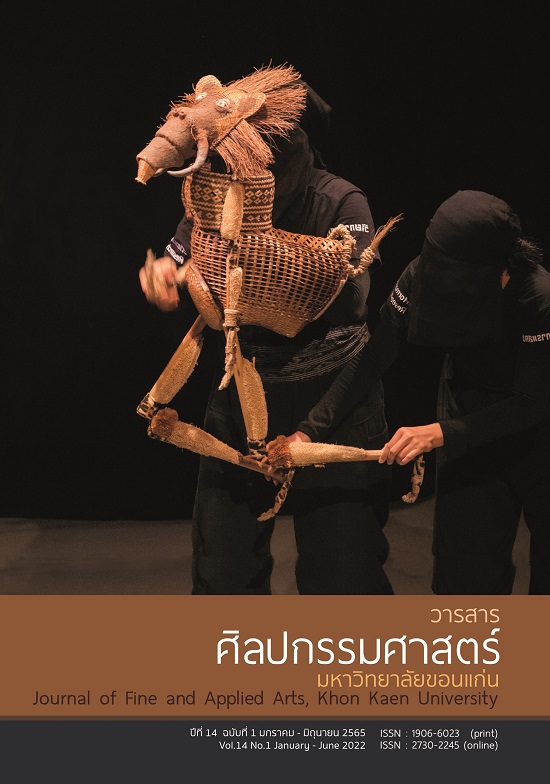The Development of ceramic clay suitable for pottery from Nong Bua Rawe’s Colored clay mineral.
Main Article Content
Abstract
This research studies about 1. Physical properties of clay from Nongbuaraway, Chaiyaphum province. 2. The Development of ceramic clay suitable for pottery from Nong Bua Rawe’s Colored clay mineral.
Samples of Nong Bua Rawe’s Colored clay mineral. test with EDXEF Lap, slip casting ,throwing and firing at 900 and 1,200 degree Celsius in oxidation atmosphere , about firing at 900 degree Nong Bua Rawe’s Colored clay mineralhas strength value 280.30Kg/cm2 , shrink value 9%, water absorption 12.16% , fire resistance and the color change to reddish brown but can not measure about strength value, shrink value ,water absorption ,non fire resistance and the color change to dark gray at 1,200 degree. The finding show that the Nong Bua Rawe’s Colored clay mineral wasn’t suitable for pottery . Purposive Sampling of 36 mixtures from Triaxial Diagram of Nongbuaraway’s clay ,kaolin and Quartz were firing at 1,200 degree Celsius in oxidation atmosphere. The best ratio for pottery product is no. 19 is 30 percent Nongbuaraway’s clay, 30 percent kaolin and 40 percent Quartz, The mixture was stable during the shaping process and after firing the clay was strength value 427.43(Kg/cm2), shrink value 11%, water absorption 0 % , fire resistance and the color change to dark brown.
Article Details

This work is licensed under a Creative Commons Attribution-NonCommercial-NoDerivatives 4.0 International License.
Content and information in articles published in the Journal of Fine and Applied Arts of Khon Kaen University is regarded as the opinion and sole responsibility of the author(s) directly; therefore, editors are not obliged to agree to or share any responsibility with regard to the content and information that appears within these articles.
All articles, information, content, image, etc. that have been published in the Journal of Fine and Applied Arts of Khon Kaen University is the copyright of the Journal of Fine and Appllied Arts of Khon Kaen University. Any person or organization who wishes to distribute all or parts of the articles for further dissemination or other usage must first receive permission from the Journal of Fine and Applied Arts of Khon Kaen University before proceeding to do so.
References
กรมทรัพยากรธรณี กระทรวงอุตสาหกรรมและสิ่งแวดล้อม. (2553). การจำแนกเขตเพื่อการจัดการด้านธรณีวิทยา และทรัพยากรจังหวัดชัยภูมิ. กรุงเทพฯ : จันวาณิชย์ ซีเคียวริตี้ พริ้นท์ติ้ง.
ดนัย อารยะพงษ์. (2538). ความรู้พื้นฐานของการวัดและตรวจสอบคุณสมบัติของวัสดุเซรามิกส์ การวัดคุณสมบัติเซรามิกส์. เอกสารประกอบการอบรมเรื่องการวัดคุณสมบัติ วัสดุเซรามิกส์ จุฬาลงกรณ์มหาวิทยาลัย 13–17 มีนาคม 2538, กรุงเทพฯ, จุฬาลงกรณ์มหาวิทยาลัย.
ทรงพันธ์ วรรณมาศ. (2530). เครื่องปั้นดินเผา. กรุงเทพฯ : โอเดียนสโตร์.
ประดุจฤดี สารสิทธิ์. (2543). การวิจัยเพื่อการบริหารงานอุตสาหกรรม. นครศรีธรรมราช : คณะเทคโนโลยีอุตสาหกรรม มหาวิทยาลัยราชภัฏนครศรีธรรมราช.
ปรีดา พิมพ์ขาวขำ.(2538). วัตถุทนไฟ. กรุงเทพฯ : จุฬาลงกรณ์มหาวิทยาลัย.
ไพจิตร อิ่งศิริวัฒน์. (2541). เนื้อดินเซรามิกส์. กรุงเทพฯ : โอเดียนสโตร์.
ไพจิตร อิ่งศิริวัฒน์. (2541). รวมสูตรเคลือบเซรามิกส์. กรุงเทพฯ : โอเดียนสโตร์.
มัลลิกา ชัยชนะ. (2545). การวิจัยและพัฒนาเพื่อใช้ประโยชน์จากดินขาวลำปาง ในการนำมาผลิต ผลิตภัณฑ์เอิร์ทเทนแวร์ (Earthenware). หน่วยเทคโนโลยีเนื้อดินและเคลือบ ศูนย์พัฒนาอุตสาหกรรมเครื่องเคลือบดินเผา สำนักงานอุตสาหกรรม.
สารานุกรมเสรี. (2557). อำเภอหนองบัวระเหว. ค้นเมื่อ 3 เมษายน 2560, จาก https://th.wikipedia.org/wiki/อำเภอหนองบัวระเหว
อายุวัฒน์ สว่างผล.(2541). วัตถุดิบที่ใช้แพร่หลายในงานเซรามิกส์. กำแพงเพชร : สถาบันราชภัฏกำแพงเพชร.
องอาจ นฤภัย และคณะ. (ม.ป.ป). ปัญหาและการแก้ไขความเสียหายในผลิตภัณฑ์เซรามิกส์. กรุงเทพฯ : กรมส่งเสริมอุตสาหกรรม.
Japan International Cooperation Agency [JICA]. (1980). Ceramic Engineering. Japan : JICA.


